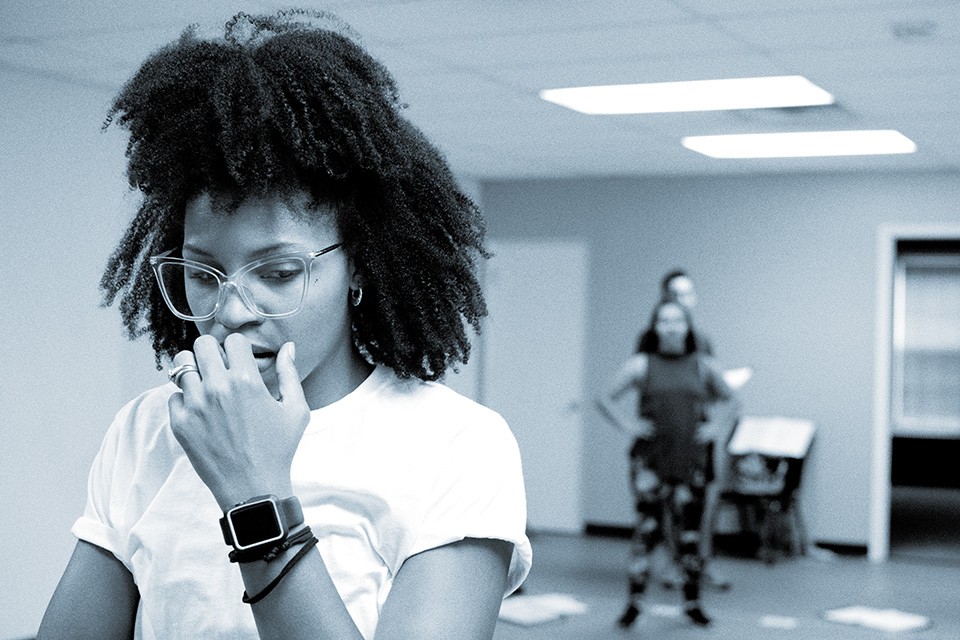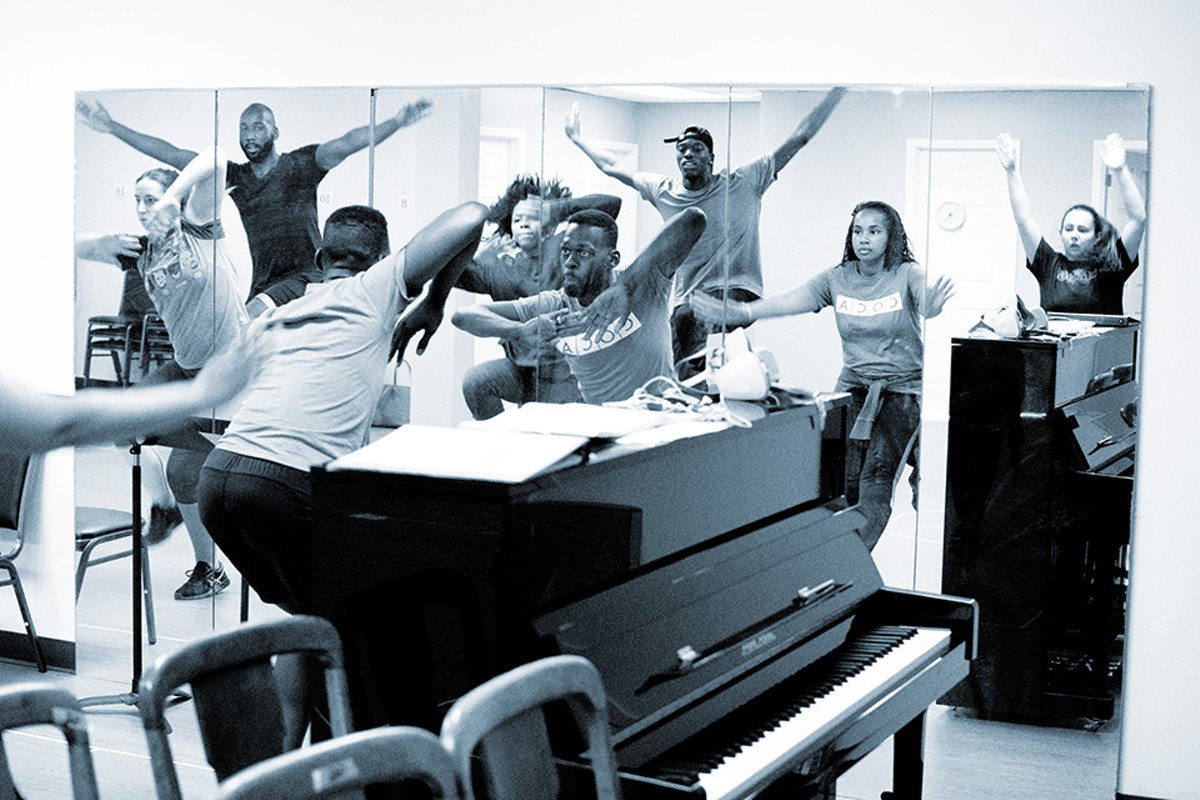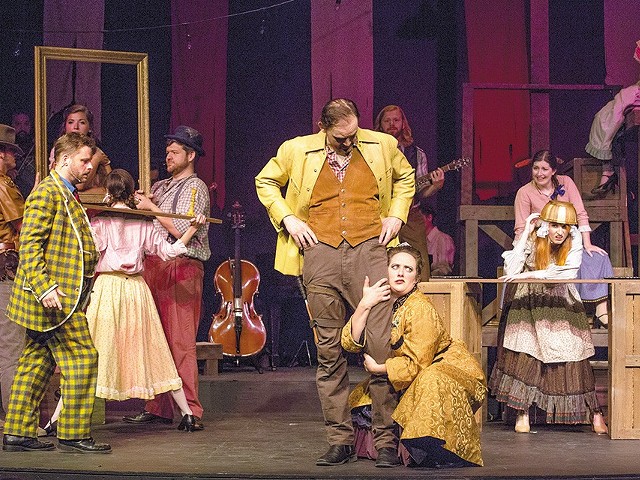
That year, Healy moved to St. Louis, where he had family and had accepted a job teaching and music-directing in the vocal department at COCA. He came to town about a month after prosecutors announced Officer Darren Wilson would face no criminal charges for the fatal shooting. And it was then that he realized that The Gringo needed to be told.
"That was the moment where I remembered what I was writing before, and I was like, 'Well, this is relevant,'" Healy says. "And obviously I was paying attention to Michael Brown and all that when it happened, and it was in the back of my mind. But once I moved up here I was like, 'Yep, this is the story that I need to resurrect now,' because I think what happened down there is pretty similar."
The result may be a musical that stars a white kid, but it is not about a white kid — rather, Ishmael is what Healy calls a "backseat protagonist" who tries and fails to drive the story. Instead, The Gringo spotlights the stories of the people Ishmael comes in contact with, many of whom are people of color with complex lives and experiences much different than his own.
The story deals with modern issues — and is filled with elements that plant it solidly in the 21st century. Dialogue only makes up about five to ten minutes of the show; the rest of the play is told via music and choreography influenced by the people and cultures depicted on stage. The score includes many forms of Latin music, including salsa, merengue and bossanova, with rap also making the occasional cameo.
The dancing, too, is inspired by the various music styles and physicalizes the themes of the show. Case in point: One of the songs, "On the Internet," takes places on Tinder, with the characters on their phones — and yes, Page-Sanders cleverly ties a swiping motion into the dancing. And upon a second viewing, you'll notice the way his choreography in the opening number, "The Streets Are Still Grey in Miami," uses dance to refer to the various themes and relationships you learn about later in the show.
In its simplest terms, The Gringo is a love triangle between characters of varying levels of privilege. But unlike many musicals, it takes the thin archetypes you're accustomed to seeing on stage — the ingenue, the jealous boyfriend, the best friend — and completely breaks them down by the second act, showing how much more there is to each one, just like in real life.
"I think what Ishmael learns in the show is to view those who we don't think about because they're not on our radar, to view those people when we're thrust into their world, to view them complexly. And I think the more we don't put others in little boxes, the less we'll hate each other," Healy says.
It's an idea worth listening to in St. Louis.
"Despite the screaming and yelling we do, we don't see each other complexly a lot in this city and in the county and the metro area at large," Healy says. "The Delmar Divide is one of those many lines that we draw, and stories like The Gringo seek to blur those things and make people of different classes and colors see each other a little bit more complexly and understand that our lives are as complex as theirs."

Matthew R. Kerns, the executive director of St. Lou Fringe, definitely sees the potential in such a story.
Kerns has come to the audition for The Gringo to scout talent for a different part of the festival, the national headlining act. Stepping out of the dance studio, Kerns explains that he connected with Healy during St. Lou Fringe last year, when he hired him to be the music director for that year's national headliner.
He picked a good person for the job — beyond Healy's obvious credentials at COCA and his work with the Republik, he has extensive training in both music and theater. He began with violin lessons at age five, later picking up both voice and a number of other instruments, including piano, guitar and drums. He also has experience performing, starting with a production of Joseph and the Amazing Technicolor Dreamcoat at age fourteen and eventually working with some semi-professional companies in Ft. Lauderdale.
Healy went to public performing-arts elementary and middle schools, both magnet schools that he says were formative in exposing him to music as well as a variety of people and cultures. After high school, Healy returned to his alma mater to music-direct competitive high school theater.
It didn't take long for Kerns to see Healy's potential.
"It was almost instantly where I was like, 'This kid is going places. This kid is going, like, all the way.' He's so talented, and I wanted to, and continue to want to, help him do exactly what the Fringe does, which is incubate new work and elevate it to the next place," Kerns recalls. "And so I wanted to give him an opportunity, because I really feel like The Gringo has some chops to it to go far."
In the summer of 2016, Healy held his first audition for The Gringo, presenting a reading of scenes from Act One that featured the three leading actors who have been with the project ever since. Additional actors were brought on board to perform a full staged reading and create a cast recording. After The Gringo was picked up by St. Lou Fringe, Healy also found himself in the producer's chair, cueing the creation of his theater production and education company, Fly North Music, to see The Gringo to the fringe festival.
The enthusiasm has been palpable. That cast recording? It had a goal of $2,000 on fundraising site Indiegogo, and it ended up earning $5,797. The funds needed to produce The Gringo at the fringe festival? They've all been secured thanks to a number of local fundraisers and 50-plus backers, who have ranged from friends to students' parents to strangers. And those staged readings that helped get all of this started? Well, we'll get to that in a moment.
If history is any indication, St. Lou Fringe could only increase the momentum. In 2016, for example, a show titled Count Time! that debuted at the festival. The play tells the story of a woman named Patricia Prewitt who was wrongfully incarcerated for her husband's murder. Count Time!, which received an award for best production at the fringe festival, went on to become a Missouri Arts Council touring show and now tours around the state. Some of the national headlining acts, too, head to the East Coast after incorporating the feedback they get at St. Lou Fringe.
But before The Gringo can reap any potential benefits from the festival, it needs a cast. Most of the principal roles will be played by the actors who originated the parts, but spots for a number of supporting characters and the ensemble have yet to be filled.
Kerns heads to a small music classroom at COCA, where auditionees are now lined up out in the hallway, music books in hand. The air is a mix of nervous energy and chilly February temperatures creeping through the windows behind the casting table as each performer enters to sing a chosen cut of music.
One by one, they give their sheet music to Healy, who is in his element accompanying at the piano. He sight-reads everything he's handed, from staples cut from Chicago and Hamilton to more obscure samples from lesser-known musicals. Sometimes he asks the singer to demonstrate an additional song. Sometimes he has them perform scales to assess their vocal range. Every time, the casting team discusses their options after the potential actor leaves the room. Ultimately, the cast ends up being made up entirely of St. Louis actors — a rarity for many productions, Page-Sanders muses later, but also one of Healy's goals for the St. Lou Fringe version.
Page-Sanders, a COCA-kid-turned-teaching-artist and professional dancer, is impressed with the number of actors that showed up to audition.
"I just think that when it comes to art, I think that people just want that opportunity to be a part of something new. And especially in St. Louis, I think artists of color are so underrepresented in the community," he says. "So to know that there is somebody who wants to tell one of the many stories of our community makes people want to be a part of that."
In the end, they land both a diverse and accomplished group. The majority of the cast is made up of people of color, including actors of African American, Latinx and Asian descent. There are a wide variety of backgrounds: an actor from rural Missouri, an activist, a single mom, a few college students. Some are prominent community theater actors with nine-to-five jobs; another is a dance instructor who attended the American Musical and Dramatic Academy; still another is a COCA grad with a number of Muny credits.
It's not until mid-July that the cast starts rehearsals for St. Lou Fringe. In a phone interview a few days before rehearsals begin, Kern explains that he thinks The Gringo has the essential ingredients to be a success: a story that is compelling and real, and music that is smart, innovative and unlike anything else out there.
"I see The Gringo being picked up by regional theaters across the country," he says of its potential following St. Lou Fringe, "and I really could seriously see The Gringo in an off-Broadway run."






